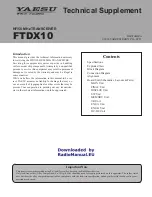Summary of Contents for MDT
Page 1: ...MDT Construction Manual Issue 2 Page 1 MDT DSB TRANSCEIVER CONSTRUCTION MANUAL ...
Page 8: ...MDT Construction Manual Issue 2 Page 8 5 MDT BLOCK DIAGRAM Figure 3 MDT Block diagram ...
Page 12: ...MDT Construction Manual Issue 2 Page 12 Figure 4 Carrier oscillator ...
Page 13: ...MDT Construction Manual Issue 2 Page 13 Figure 5 Mixer ...
Page 14: ...MDT Construction Manual Issue 2 Page 14 Figure 6 Microphone Amplifier ...
Page 15: ...MDT Construction Manual Issue 2 Page 15 Figure 7 Transmit ...
Page 16: ...MDT Construction Manual Issue 2 Page 16 Figure 8 Receive Audio ...
Page 32: ...MDT Construction Manual Issue 2 Page 32 Figure 20 Component overlay ...



































